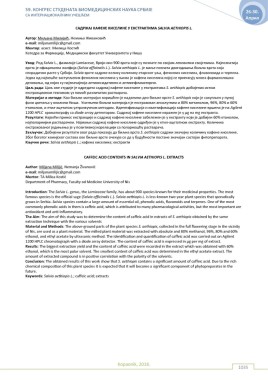Page 1041 - 59. КОНГРЕС СТУДЕНАТА БИОМЕДИЦИНСКИХ НАУКА СРБИЈЕ СА ИНТЕРНАЦИОНАЛНИМ УЧЕШЋЕМ
P. 1041
59. КОНГРЕС СТУДЕНАТА БИОМЕДИЦИНСКИХ НАУКА СРБИЈЕ 26-30.
СА ИНТЕРНАЦИОНАЛНИМ УЧЕШЋЕМ Април
САДРЖАЈ КАФЕНЕ КИСЕЛИНЕ У ЕКСТРАКТИМА SALVIA AETHIOPIS L.
Аутор: Миљана Милијић, Немања Живановић
e-mail: miljanamilijic@gmail.com
Ментор: асист. Милица Костић
Катедра за Фармацију, Медицински факултет Универзитета у Нишу
Увод: Род Salvia L., фамилије Lamiaceae, броји око 900 врста које су познате по својим лековитим својствима. Најпознатија
врста је официнална жалфија (Salvia officinalis L.). Salvia aethiopis L. је мање позната двогодишња биљна врста која
спорадично расте у Србији. Salvia врсте садрже велику количину етарског уља, фенолних киселина, флавоноида и терпена.
Једна од најчешће заступљених фенолних киселина у њима је кафена киселина којој се приписују многа фармаколошка
деловања, од којих су најзначајнија антиоксидативно и антиинфламаторно.
Циљ рада: Циљ ове студије је одредити садржај кафене киселине у екстрактима S. aethiopis добијених истом
екстракционом техником уз помоћ различитих растварача.
Материјал и методе: Као биљни материјал коришћен је надземни део биљне врсте S. aethiopis који је сакупљен у пуној
фази цветања у околини Ниша. Уситњени биљни материјал је екстрахован апсолутним и 80% метанолом, 96%, 80% и 60%
етанолом, и етил-ацетатом ултразвучном методом. Идентификација и квантификација кафене киселине вршена је на Agilent
1200 HPLC хроматографу са diode array детектором. Садржај кафене киселине изражен је у µg на mg екстракта.
Резултати: Највећи принос екстракције и садржај кафене киселине забележен је у екстракту који је добијен 60% етанолом,
најполарнијим растварачем. Најмањи садржај кафене киселине одређен је у етил-ацетатном екстракту. Количина
екстрахованог једињења је у позитивној корелацији са поларношћу растварача.
Закључак: Добијени резултати овог рада показују да биљна врста S. aethiopis садржи значајну количину кафене киселине.
Због богатог хемијског састава ове биљне врсте очекује се да у будућности постане значајан састојак фитопрепарата.
Кључне речи: Salvia aethiopis L.; кафена киселина; екстракти
CAFFEIC ACID CONTENTS IN SALVIA AETHIOPIS L. EXTRACTS
Author: Miljana Milijić, Nemanja Živanović
e-mail: miljanamilijic@gmail.com
Mentor: TA Milica Kostić
Department of Pharmacy, Faculty od Medicine University of Nis
Introduction: The Salvia L. genus, the Lamiaceae family, has about 900 species known for their medicinal properties. The most
famous species is the official sage (Salvia officinalis L.). Salvia aethiopis L. is less-known two-year plant species that sporadically
grows in Serbia. Salvia species contain a large amount of essential oil, phenolic acids, flavonoids and terpenes. One of the most
commonly phenolic acids in them is caffeic acid, which is attributed to many pharmacological activities, but the most important are
antioxidant and anti-inflammatory.
The Aim: The aim of this study was to determine the content of caffeic acid in extracts of S. aethiopis obtained by the same
extraction technique with the various solvents
Material and Methods: The above-ground parts of the plant species S. aethiopis, collected in the full flowering stage in the vicinity
of Nis, are used as a plant material. The milled plant material was extracted with absolute and 80% methanol, 96%, 80% and 60%
ethanol, and ethyl acetate by ultrasonic method. The identification and quantification of caffeic acid was carried out on Agilent
1200 HPLC chromatograph with a diode array detector. The content of caffeic acid is expressed in μg per mg of extract.
Results: The biggest extraction yield and the content of caffeic acid were recorded in the extract which was obtained with 60%
ethanol, which is the most polar solvent. The smallest content of caffeic acid was determined in the ethyl acetate extract. The
amount of extracted compound is in positive correlation with the polarity of the solvents.
Conclusion: The obtained results of this work show that S. aethiopis contains a significant amount of caffeic acid. Due to the rich
chemical composition of this plant species it is expected that it will become a significant component of phytopreparates in the
future.
Keywords: Salvia aethiopis L.; caffeic acid; extracts
Kopaonik, 2018.
1035

